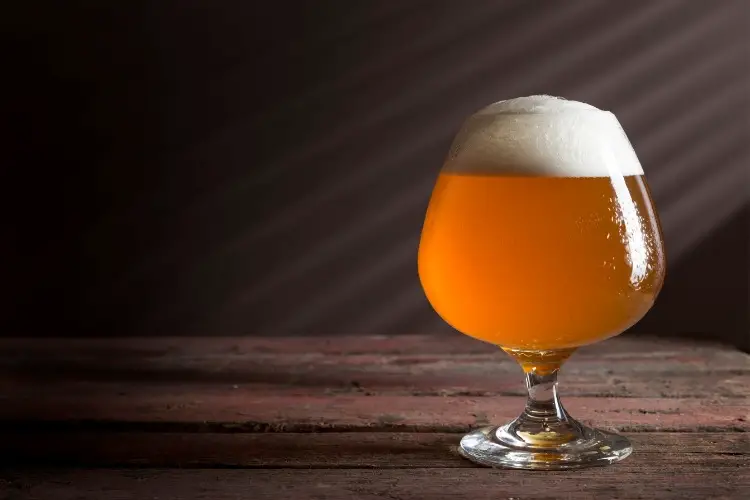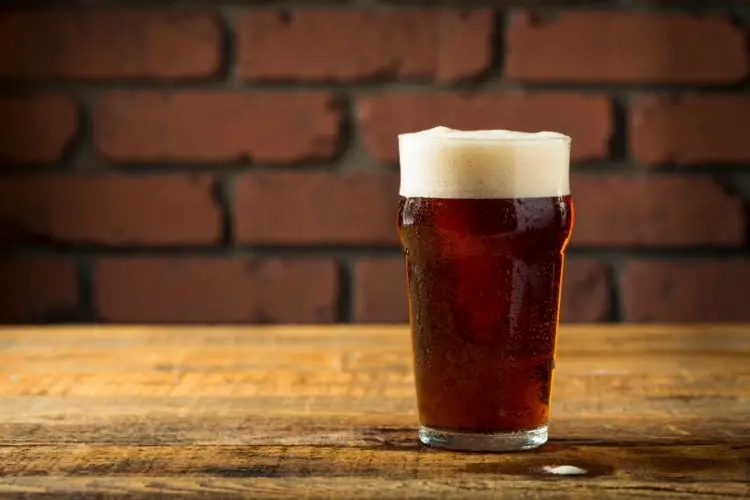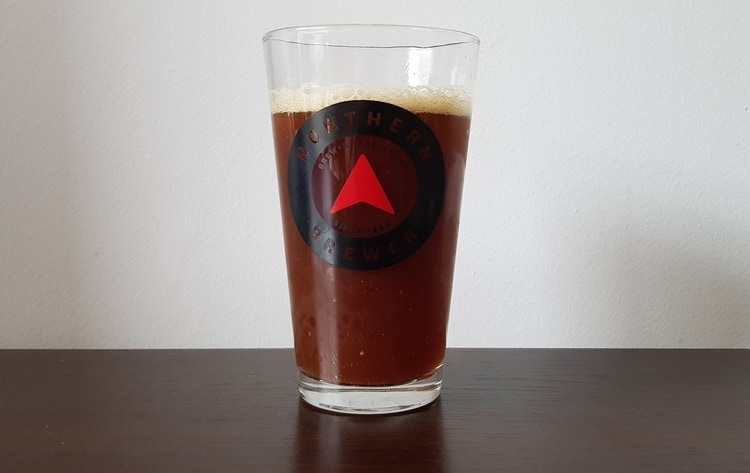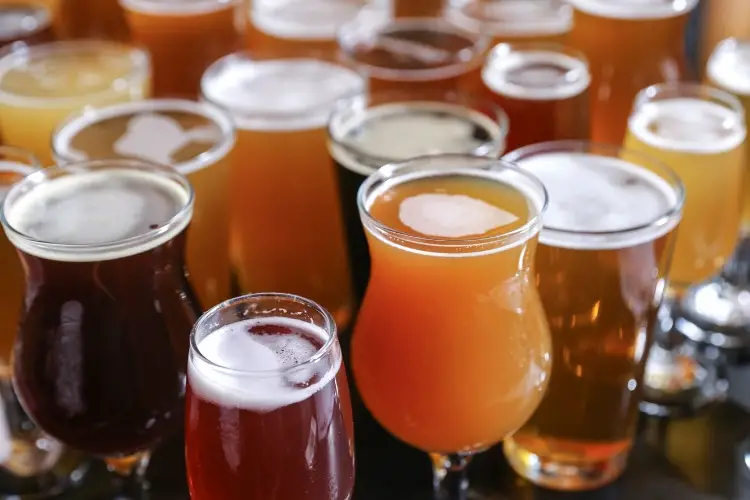When you first get started with homebrewing beer, it’s crucial to start with easy beers. Not only does starting with something complicated increase your chances of making a mistake during the brewing process, but you’re also more likely to brew something unpalatable if you start playing around with experimental ingredients and additives without knowing some basic concepts of brewing by heart first.
These are the twelve easiest beers to brew:
- American Pale Ale
- American Amber Ale
- American Brown Ale
- American Wheat Ale
- Porters
- Altbier
- Dunkelweizen
- Dubbel
- Hefeweizen
- Belgian Saison
- Irish Stout
- Something You Already Like
This list encompasses a large variety of beer styles to suit every palate, so you’re bound to find something you like. Read on to find out more about these different types of beer and find some easy recipes for homebrewing.
American Pale Ales
American pale ales are known as one of the classic American beers.
These pale ales are inspired by English and Indian pale ales, but with American hops as the dominant flavor and aroma present in the beer.
American pale ales also have citrus and floral notes.
American pale ales are typically a bright copper color with a bright white, moderate head.
They are highly carbonated and are usually served cooler than their English counterparts.
Cascade hops are the hops that are most often featured in this variety of beer.
Before the advent of American IPAs as the most popular craft beer in the world in 2011, American pale ales were considered the most popular craft beer style.
Why American Pale Ale?
Because American pale ales are a moderately heavy pale ale with a moderate to strong hop aroma, they are an excellent choice for people who find stronger flavored pale ales tougher to stomach.

American Amber Ales
American amber ales are very similar to the amber ales brewed across central Europe, but the significant difference is in the types of ingredients used.
American amber ales feature American hops, and these beers are a more citrusy version of the traditional English bitter.
Like European amber ales, American amber ales are so named because of their deep rust or amber coloring, and clarity is an attractive trait in amber ales.
American amber ales feature a malty caramel flavor with notes of citrus and hops. They are supposed to have a large off-white head that is persistent.
Why American Amber Ales?
Amber ales are a fantastic choice for homebrewers who aren’t very experienced but still want to experiment with fining agents and clarifiers.
Amber ales are a good choice for novice homebrewers who would like to experiment with a few different additives such as malts or hops without throwing out the overall flavor profile of the beer.
American Brown Ales
American brown ales have a bitter flavor profile with notes of caramel, chocolate, and roasted malt.
Because it is a little richer than American lagers and pale ales, it is well suited to colder weather and holiday occasion.
This makes it a great beer to show off at Thanksgiving or Christmas to prove your brewing skills for the first time with relatives and friends.
Brown ale is an excellent moderate beer style that works well with a wide variety of food pairings, which means that:
- You’re more likely to find it palatable.
- It’s usually not going to clash with what you want to serve it with.
Why American brown ales?
American brown ale is an American beer inspired by English brown ales, and brown ales, in general, are a good bet for beginner brewers because it is naturally bitter (which covers a multitude of sins during the brewing process).
Its dark coloring means that haze or other issues are less noticeable.

American Wheat Ales
One significant advantage of wheat beers like American wheat ales (and any wheat beers) is that any hazing that occurs—biological or otherwise—is okay.
Wheat beers are known for a hazy or cloudy appearance due to their high levels of proteins, so this can help cover any beginner’s mistakes that may lead to haziness during the brewing process.
American wheat ales are a direct descendant of the Belgian and central European wheat beers that migrated with European immigrants across the Atlantic Passage.
Why American Wheat Ales?
Wheat beers are a suitable choice to brew throughout the year because their medium body makes them a great pairing with many different foods.
The fact that wheat ales are rarely filtered and don’t require secondary fermentation to observe their best flavors makes them an excellent choice for brewers who want a quick turnaround on their first batch of beer.
Sometimes an early sense of satisfaction can be just what a novice brewer needs to stay on course with the hobby.
Porters
Porters are a dark European style beer that features brown malt and bitter hoppiness.
Porters are similar to stouts, except that they are slightly lighter in color and body. Robust porters from America tend to be stronger in flavor than Baltic or Brown porters, which have a sweeter and more mellow flavor.
Why Porters?
Porters are a top-fermented ale that is forgiving for beginners, making it an easy style of beer to start with.
Another advantage of porters when it comes to novice homebrewing is that porters benefit from a hard water environment, making them a better option for people with hard tap water who don’t want to brew with distilled or bottled water.
Because porters have a history of being several beers mixed in one mug, you can get away with some muddled flavors if your first porter doesn’t turn out perfect.
Chocolate malt can be added to improve a porter’s flavor and aroma, though too much should be avoided to avoid giving the beer a burnt or bitter flavor.

Altbiers
Altbiers are a German-style old beer with floral, hoppy, and pepper notes.
Like porters, altbiers are a top-fermented beer style, but unlike porters, altbiers have a lighter coloring more similar to a brown or golden ale.
While altbiers are traditionally a German beer, American altbiers have also made their appearance on the brewing market, with American hops taking the place of traditional European hops.
For people who like hoppy beer, altbiers are a good option.
Why Altbiers?
Authentic altbiers are some of the more dominant hoppy beer styles there are, so this type of beer may be a little strong-tasting for some beginners.
Before brewing a batch, beginners should try an altbier or two in a beer garden or beer tasting bar to get a sense of their flavor profiles and whether they would be appealing in homebrew (advice that goes well for any beer style tried).
Dunkelweizen
Dunkelweizen is a dark wheat beer that is a good option for autumn parties, and its dark coloring can easily cover any haze that results from the brewing process.
Since it is a wheat beer, it is more likely that some natural cloudiness will occur during the brewing process anyway.
Dunkelweizen has a strong malt flavor with distinctive notes of clove and banana, but this beer also has notes of apple, nutmeg, and vanilla.
These spicy notes make it a great pairing with fall foods such as roasted meats and baked dishes.
Dunkelweizen beers are a good option if you prefer beers that have more robust fruity flavors and notes of malt rather than a strong flavor of hops or florals. Dunkelweizen beers are an excellent middle ground between weissbiers and Munich dunkels. The main thing that differentiates dunkelweizen beers from weissbiers is that the grain used in them is roasted, resulting in a stronger malt and caramelized flavor.
Dubbel
Dubbel is a very dark Belgian style beer with a large, off-white head.
Like porters and stouts, dubbels have intense caramelized flavors with notes of chocolate and banana.
Because dubbels naturally feature several yeasty flavors, these beers are a suitable choice for beginners who might not be able to accurately verify when the fermentation process has ended, leading to some yeast flavors in the final brew.
Dubbels are perfect for people who like richer or more malty beers rather than dry and hoppy beers.
Why Dubbel?
One of the distinguishing factors of dubbels is also a relatively high alcohol volume, so if you’re a beginner who is looking for easy homebrew that packs a punch, dubbels are a set of recipes to look at.
Making dubbel is a great way for novice brewers to learn precise mashing techniques, the management of the fermentation process, and other technical homebrewing skills that can serve the brewer well with other recipes that follow.
Even though the brewing process for dubbels is relatively straightforward, the resulting brew has a complex and sophisticated flavor that is a rewarding result for even the newest brewers.
Belgian Saison
Belgian Saison beers are also known as farmhouse ales and are known for their warm, fruity, and spicy flavors.
Belgian Saisons have a naturally yeasty aroma (some even describe as horsey or goaty), and this strong flavor profile can help cover up brewing mistakes for beginner brewers.
Why Belgian Saisons?
Belgian Saisons are regarded as warm weather or summer beers, which makes them an excellent choice for your summer homebrewing season.
Many different additions can be added to Belgian Saisons during secondary fermentation to add different flavor notes to the overall taste of the beer.
Traditionally Belgian Saisons incorporate local botanicals and herbs, so if you’re a gardener with an herb garden who wants to get into homebrewing, Saison can be a way to incorporate both hobbies. Belgian brewers use hops as well as other additives to change up the flavor of the ales, and in the brewing of signature Saisons, whimsy is a valued trait.
Irish Stout
Irish stouts are a thick, almost bready dark beer with a persistent off-white foam head.
Unlike dessert stouts, Irish stouts are a dry stout with a bitter, roasted flavor profile and caramelized notes.
In Irish stout, roasted barley lends a distinct coffee-like aroma and flavor that is very popular with fans of dark beer.
Irish stouts are known more for their creamy texture and mouthfeel than they are for their flavor profile, which is similar to many other dark brown ales and porters.
Classic food pairings for Irish stout include pub fares like raw oysters, cheddar, and roasted meat stews.
Why Irish Stout?
Stouts are a suitable choice for beginner brewers because their dark coloring covers up any haze that may occur, and their overpowering roasted flavors are good at covering up any off-flavors that are introduced via less-than-perfect brewing techniques.
Something You Already Like
Even if your favorite type of beer isn’t one of the ones listed above, that doesn’t mean you still can’t brew it!
If you’re already head over heels in love with a particular type of beer, even if it’s a bit more complicated to brew, your passion for the beer type will likely make up for any mistakes you make along the way.
It’s more important to be enthusiastic about the hobby than it is to make the easiest beer you can, even if you don’t like the taste of it.
While there is a higher risk that something may go wrong in a complicated recipe, someone who has the drive to perfect a specific type of beloved beer is less likely to be discouraged by having to brew multiple iterations of similar beers.
If you make the perfect American pale ale your holy grail, then the chances are high that you’ll eventually come up with one that you’re proud to call your signature beer.
No matter which recipe you choose to try first, the most important thing is to follow the instructions as closely as possible, especially as they pertain to time periods, ingredient measurements, and specified temperatures.
While swapping up different types of malts or hops isn’t likely to spoil a batch of beer, accidentally taking it out of the fermenter too early or adding too much of one ingredient can.

What Makes for an “Easy” Homebrew?
Certain beer recipes are definitely more complicated and difficult to master than others.
So, what exactly are the traits that make a homebrew recipe easy to tackle for beginners?
- Easy to salvage: Easy homebrews can tolerate temperature fluctuations, mismeasured ingredients, and other brewing mistakes without drastically affecting the resulting beer. Happy little accidents won’t sabotage weeks of prep work and discourage you from making a second brewing attempt.
- Doesn’t require secondary fermentation: Not only do these types of beer taste good young, but they also don’t require weeks of aging or mellowing to have a robust and pleasing flavor. Lack of secondary fermentation makes for a much faster brew, and it also cuts down on the necessary amount of equipment and ingredients needed.
- Darker in color: Not only do light lagers require weeks of extra TLC to achieve the same brilliance as darker beers in a shorter time frame, but darker beers also help hide haze and cloudiness that can occur from brewing processes that are still unrefined by lack of experience.
- Basic flavor profile: While some easy beginner beers can be experimented with quite easily, the main advantage of beginner beers is that they have a distinct and identifiable flavor profile, so it’s easier for new brewers to tell how close they hit to the mark when it comes time to taste the final result.
- High levels of head retention or carbonation: Carbonation levels can be somewhat challenging to control for beginner brewers, so choosing beer types that have a naturally high level of carbonation can be easier to handle than those which require a more moderate level of carbonation.
- Strong flavor profiles: Beers with robust hoppy or bitter flavor profiles, such as American pale ales or Irish stouts, are better at covering up any off-flavors that may result from the brewing process when novice brewers are still figuring out how everything works. While these stronger flavor profiles may not as be as universally liked as some of the more mellow types of beer, it is harder to screw these funkier beers up.
Having success in a homebrewing project comes down to being able to follow a recipe and follow it to the letter.
If you can follow a recipe, you can brew just about any kind of beer that has ever been crafted.
Supplies for Beginner Homebrewing
There are only a few necessary supplies you need to get started in homebrewing, so if you think it’s a complicated hobby to get set up in, think again.
While it’s easy to get sucked into a world of exotic additives and imported malts, here are the only things you need to get going with homebrew:
- Brewing kettle: While beer can be brewed in a large stockpot, the best option for brewing beer if you brew at least 5 gallons is to use a specialized brewing kettle that is designed explicitly for homebrewing activities. These kettles come with built-in spigots, scale markings, and thermometers for careful monitoring of temperature fluctuations.
- Fermenter: The best fermenters for brewing beer are airtight to prevent oxidation, and many function as a brewing kettle as well, making them a practical choice for keeping your homebrewing setup as minimal as possible.
- Funnel: While brewing funnels aren’t a necessary part of a homebrewing operation, they make transferring brewing liquids from one container to another much more comfortable and faster, minimizing the amount of oxygen that the batch is exposed to during the racking process. A funnel with a filter can be used to transfer the wort to the fermenter to ensure that no large particles make it from the wort into the final brew.
- Sanitizing agents: Sanitizing agents are an essential part of the homebrew setup because, without sanitized equipment, beer can be infected with bacteria in the surrounding environment that can cause it to spoil and develop off-putting flavors. To avoid this, sanitizing agents are used to sterilize all brewing equipment similarly to the way that canning equipment is sterilized before use. Bleach is a commonly used sanitizer.
- Auto-siphon: Auto-siphons are used to move beer from one container to another and allow the beer to be racked without picking up the layer of sediment on the bottom of the fermenter or secondary fermenter.
- Stir spoon: While you wouldn’t consider a spoon a specialized piece of equipment, in homebrewing, the stir spoon is a spoon that is capable of withstanding the boiling temperatures that wort is brewed at without melting or conducting heat to the stirrer’s hand. Stir spoons also feature a smaller end that can be used to stir down the neck of carboys and secondary fermenters to agitate beers during secondary fermentation.
- Beer ingredients: The ingredients that you choose to brew with will vary wildly from beer to beer, but for beginner brewers, it’s usually easy to brew beers from a recipe kit rather than try to measure out ingredients yourself. Recipe kits have the benefit of being pre-measured, so beginners are less likely to make a mistake in doling out their ingredients, potentially ruining weeks’ worth of work with one oversight.
- Glass carboys: If you plan on brewing a beer that requires a secondary fermentation period for either flavor or clarity, glass carboys are a good investment as far as necessary homebrewing equipment goes. Secondary fermentation and cold conditioning a finished beer are two of the best ways to end up with a bright, tasty product in the end. Glass carboys can also be used as primary fermenters.
- Priming sugar: For bottle-conditioned beers, priming sugar is used to help generate some residual carbon dioxide within the bottled beer, making sure that it doesn’t taste flat or stale and retains both head and carbonation.
- Bottles: While green or light-colored bottles can be aesthetically-pleasing, dark-colored bottles will help prevent beer from skunking because of UV exposure and are designed to be used over and over again, making them a valuable investment for a homebrewing kit. The number of bottles necessary is dependent on how many bottles you can reasonably chill at once, and how many gallons of beer you’re making at a time. You can of course also reuse and recycle your own beer bottles, as long as they are dark-colored and you clean them well.
That’s what you need. But for an easy start, homebrewing kits are a really good option for beginners. The kits usually provided you with everything you need but the brewing kettle (some do).
Beginner Tips for Better Homebrewing
When you’re first getting started as a beginning homebrewer, it can be intimidating.
There seems to be a world of unfamiliar terms and exotic ingredients to learn.
Never fear novice—here are some of the best tips for getting off on the right foot in your homebrewing adventures:
- Keep your equipment sterilized. Do not just sterilize your kettle and fermenter. Sterilize your stir spoon and anything even remotely near your brewing equipment. Wild yeasts and other bacteria are one of the major culprits behind homebrews that turn out tasting off.
- Keep notes. You never know when you’re going to find your new favorite beer recipe of all time, so be sure to keep track of any deviations you make to recipes or signature additives that you decided to try. Keeping a homebrewing journal can also be a good way for you to look back and see your progress as a brewer, which is a satisfying aspect of the hobby.
- Read the recipe, then re-read it twice. Most mistakes in brewing, cooking, baking, candlestick-making, and most other artisan crafts on the planet can be linked back to somebody not following the directions. You may not even realize you’re skimming a recipe until you find out you’ve left out something crucial. Re-reading a recipe helps you make sure you understand the basic concepts behind the recipe and aren’t missing anything.
- Observe your beer carefully. Keeping a close eye on your beer throughout the fermentation process helps teach you about what to look for in terms of appearance, smell, and flavor throughout the brewing process. The more you perform these activities, the more intuitive you’ll become about when fermentation is ending and the beer needs to be racked.
The number one thing that contributes to better homebrewing is lots of practice, so if your first batch of beer doesn’t turn out quite as you imagined, don’t be discouraged.
It’s important to get back on the horse and try again (maybe with an easier recipe?) and see if you can’t have more success in the second go-around.
Homebrewing is Surprisingly Forgiving for Beginners
While homebrewing might seem like a complex chemical process (and it kind of is), the more brewing practice you get in, the better your resulting beers will inevitably be.
Luckily, there are plenty of easy beer recipes and beer types that can be tried to find a few favorites worth refining. Once you get the basic processes down, it’s easy to develop enough confidence to try more wild and experimental brews.
When you’re willing to continually learn about the chemical concepts behind brewing and refine your brewing practices to reflect that expertise, it won’t be long at all before you are brewing historically authentic beers that will make you proud.
